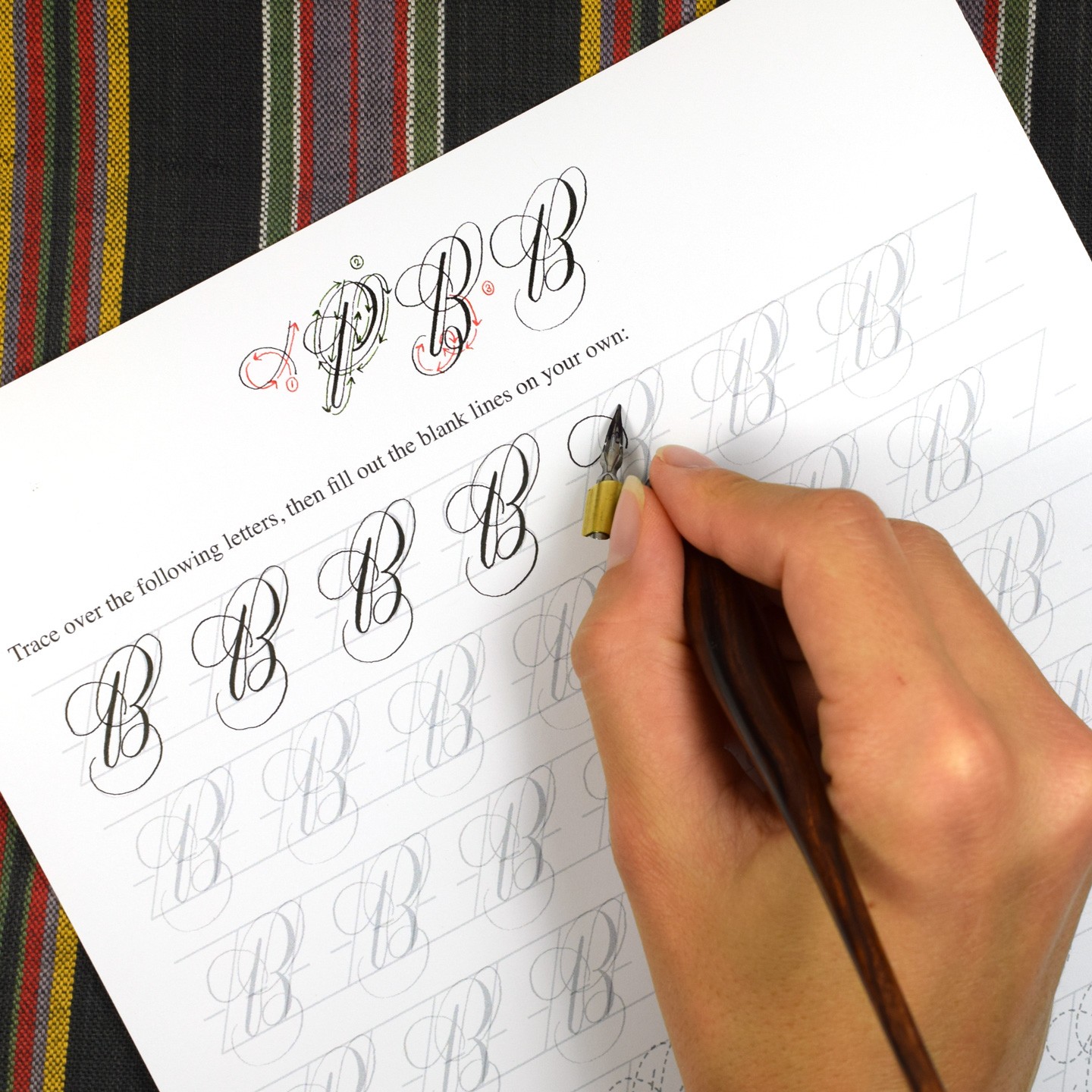Learning calligraphy can be an enriching experience, and at LEARNS.EDU.VN, we believe everyone can master this beautiful art form with the right guidance and dedication. Discover the time investment, essential skills, and actionable tips to excel in calligraphy, transforming your handwriting into elegant artistry. Explore methods, practice strategies, and estimated timelines to ensure success in your calligraphy journey with lettering, hand lettering, and penmanship mastery.
1. Understanding the Calligraphy Learning Curve
The journey to mastering calligraphy is a personal one, varying significantly from person to person. Several factors influence how quickly you can learn calligraphy, including your prior experience with handwriting and art, the amount of time you dedicate to practice, and the learning approach you adopt. Understanding these factors can help you set realistic expectations and tailor your learning path for optimal results.
- Prior Experience: If you have a background in art or experience with detailed handwriting, you might find it easier to grasp the fundamentals of calligraphy. A steady hand and an eye for detail can give you a head start.
- Practice Time: Consistent practice is crucial. Those who dedicate more time each week will naturally progress faster. Short, regular practice sessions are generally more effective than infrequent, lengthy ones.
- Learning Approach: The method you choose, whether it’s self-study, online courses, or in-person workshops, can impact your learning speed. Structured courses often provide a more efficient learning path.
Here’s a breakdown of how these factors can affect your learning timeline:
| Factor | Low Impact | Medium Impact | High Impact |
|---|---|---|---|
| Prior Experience | Little to no experience with art or detailed handwriting. | Some experience with neat handwriting or basic drawing. | Extensive experience with art, drawing, or specialized handwriting. |
| Practice Time | Less than 3 hours per week. | 3-5 hours per week. | 5+ hours per week. |
| Learning Approach | Unstructured self-study with sporadic resources. | Combination of self-study and occasional workshops. | Structured online course or regular in-person instruction. |




2. Setting Realistic Timelines: Beginner to Mastery
When starting calligraphy, it’s essential to understand the different stages of learning and set achievable goals for each phase. This approach can help you stay motivated and track your progress effectively.
2.1. Beginner Level: The First Few Weeks
In the initial weeks, focus on getting acquainted with the tools and basic strokes. This stage is about building a foundation and developing muscle memory.
- Goals:
- Learn to hold the calligraphy pen correctly.
- Understand the basic strokes: hairline, downstroke, and curves.
- Practice consistent pressure control.
- Timeline: 2-4 weeks
- Practice: 15-30 minutes daily
2.2. Intermediate Level: Building Consistency (Months 2-6)
As you progress, you’ll start focusing on letterforms and connecting them to form words. This phase requires patience and attention to detail.
- Goals:
- Master the basic alphabet in your chosen style.
- Learn to connect letters smoothly.
- Practice spacing and alignment.
- Timeline: 2-6 months
- Practice: 30-60 minutes, 3-5 times a week
2.3. Advanced Level: Refining Your Skills (6+ Months)
The advanced stage involves honing your skills, experimenting with different styles, and developing your unique artistic voice.
- Goals:
- Explore various calligraphy styles (e.g., Copperplate, Spencerian, Modern).
- Develop your personal style and flair.
- Work on complex projects like invitations or artwork.
- Timeline: 6+ months to lifelong learning
- Practice: Ongoing, incorporating calligraphy into regular projects and creative endeavors
“Calligraphy is a journey, not a destination. Enjoy the process of learning and allow yourself the freedom to experiment and grow,” advises Eleanor Winters, author of Mastering Copperplate Calligraphy.
Alt Text: Calligraphy starter kit including nibs, ink, pen holder, and practice paper for beginners.
3. Key Factors Influencing Learning Speed
Several factors can significantly impact how quickly you progress in calligraphy. Understanding these elements can help you optimize your learning strategy and stay motivated.
3.1. Natural Aptitude vs. Hard Work
While some individuals may have a natural inclination for calligraphy, hard work and consistent practice are more critical for long-term success. Talent can provide a slight advantage, but dedication is what truly determines mastery.
- Aptitude: Some people naturally possess better hand-eye coordination and an innate sense of aesthetics, which can make learning calligraphy easier.
- Effort: Consistent practice, focused learning, and a willingness to correct mistakes are crucial for improvement.
3.2. Choosing the Right Style
Selecting a calligraphy style that resonates with your interests and abilities can significantly impact your motivation and learning speed. Some styles are more beginner-friendly, while others require advanced skills.
- Beginner-Friendly Styles:
- Modern Calligraphy: This style is more forgiving and allows for personal expression, making it ideal for beginners.
- Italic: Known for its simplicity and readability, Italic script is a great starting point for learning calligraphy.
- Advanced Styles:
- Copperplate: This traditional style requires precise strokes and consistent pressure, making it challenging for beginners.
- Spencerian: Renowned for its elegance and complexity, Spencerian script demands a high level of skill and control.
3.3. Learning Resources and Guidance
The resources you use and the guidance you receive play a vital role in your learning journey. Structured courses, experienced instructors, and quality practice materials can accelerate your progress.
- Online Courses: Platforms like LEARNS.EDU.VN offer structured calligraphy courses that provide step-by-step guidance, video tutorials, and personalized feedback.
- Workshops: In-person workshops allow you to learn from experienced calligraphers and receive immediate feedback on your technique.
- Books and Worksheets: Resources like Mastering Copperplate Calligraphy by Eleanor Winters and calligraphy worksheet collections offer structured exercises and valuable insights.
3.4. Practice Techniques and Consistency
Effective practice techniques and consistent effort are essential for mastering calligraphy. Focus on quality over quantity, and make practice a regular part of your routine.
- Deliberate Practice: Concentrate on specific areas for improvement, such as letter spacing or stroke consistency.
- Regular Schedule: Set aside dedicated time for practice each day or week to maintain momentum.
- Feedback and Reflection: Regularly review your work, identify areas for improvement, and seek feedback from instructors or peers.
4. Essential Skills to Master in Calligraphy
Calligraphy involves a unique set of skills that blend artistic expression with technical precision. Mastering these skills is crucial for creating beautiful and consistent lettering.
4.1. Pen Handling and Posture
Proper pen handling and posture are fundamental to calligraphy. Holding the pen correctly and maintaining a comfortable posture can prevent fatigue and improve your control over the pen.
- Pen Grip: Hold the pen gently between your thumb and index finger, with the pen resting on your middle finger. Avoid gripping the pen too tightly, as this can cause hand fatigue.
- Posture: Sit upright with your feet flat on the floor. Keep your shoulders relaxed and your wrist flexible.
- Paper Angle: Adjust the angle of your paper to a comfortable position that allows you to create strokes with ease.
4.2. Basic Strokes and Letterforms
Understanding and practicing basic strokes is the foundation of calligraphy. Mastering these strokes will enable you to form consistent and elegant letterforms.
- Basic Strokes:
- Hairline: A thin, light stroke created with minimal pressure.
- Downstroke: A thick stroke created with increased pressure.
- Oval: A curved stroke that forms the basis of many letterforms.
- Ascender Loop: A loop that extends above the x-height of the letter.
- Descender Loop: A loop that extends below the baseline of the letter.
- Letterforms:
- Practice each letter of the alphabet, focusing on consistency and proper proportions.
- Use calligraphy worksheets to guide your practice and ensure accuracy.
- Pay attention to the unique characteristics of each letter and strive to replicate them consistently.
4.3. Spacing and Alignment
Proper spacing and alignment are crucial for creating legible and visually appealing calligraphy. Consistent spacing between letters and words enhances the overall aesthetic of your work.
- Letter Spacing: Maintain consistent spacing between letters, ensuring that each letter is neither too close nor too far apart.
- Word Spacing: Use a consistent amount of space between words, typically about the width of one letter.
- Baseline Alignment: Ensure that all letters sit on the same baseline, creating a sense of order and uniformity.
4.4. Flourishing and Embellishments
Flourishing involves adding decorative elements to your calligraphy, enhancing its visual appeal and expressing your personal style.
- Basic Flourishes: Start with simple flourishes, such as extending ascenders and descenders or adding loops and curves to your letters.
- Complex Flourishes: As you become more skilled, experiment with more complex flourishes, such as adding swirls, spirals, and decorative lines.
- Balance: Use flourishes sparingly and strategically, ensuring that they complement your calligraphy without overwhelming it.
Alt Text: Printable calligraphy worksheet set demonstrating Janet Style, an elegant embellished modern calligraphy style.
5. Creating a Practice Schedule for Optimal Learning
A well-structured practice schedule is essential for making consistent progress in calligraphy. Tailor your schedule to fit your lifestyle and learning goals, and make practice a regular part of your routine.
5.1. Daily vs. Weekly Practice
Decide whether daily or weekly practice sessions work best for you. Short, daily sessions can help you maintain momentum and build muscle memory, while longer, weekly sessions may be more suitable if you have limited time during the week.
- Daily Practice: 15-30 minutes each day.
- Weekly Practice: 1-2 hours, 3-5 times a week.
5.2. Setting Specific Goals for Each Session
Before each practice session, set specific goals for what you want to achieve. This will help you stay focused and track your progress more effectively.
- Example Goals:
- Practice the letter “a” 20 times, focusing on consistent oval formation.
- Work on connecting the letters “m” and “n” smoothly.
- Practice spacing between the words “hello” and “world.”
5.3. Warm-Up Exercises
Start each practice session with warm-up exercises to prepare your hand and improve your control over the pen.
- Basic Strokes: Practice basic strokes like hairlines, downstrokes, and ovals.
- Drills: Repeat specific letterforms or connections that you find challenging.
- Relaxation: Take breaks to stretch your hand and wrist, preventing fatigue.
5.4. Incorporating Breaks
Take regular breaks during your practice sessions to avoid burnout and maintain focus.
- Short Breaks: Every 20-30 minutes, take a 5-minute break to stretch and relax.
- Longer Breaks: Every 1-2 hours, take a 15-minute break to step away from your work and refresh your mind.
6. Common Challenges and How to Overcome Them
Learning calligraphy can present various challenges, especially for beginners. Recognizing these challenges and developing strategies to overcome them is crucial for staying motivated and making progress.
6.1. Hand Fatigue
Hand fatigue is a common issue for calligraphers, especially during long practice sessions.
- Causes:
- Gripping the pen too tightly.
- Poor posture.
- Lack of breaks.
- Solutions:
- Hold the pen gently.
- Maintain a comfortable posture.
- Take regular breaks to stretch your hand and wrist.
6.2. Ink Bleeding
Ink bleeding can be frustrating, especially when working on delicate projects.
- Causes:
- Using the wrong type of paper.
- Applying too much pressure.
- Using low-quality ink.
- Solutions:
- Use calligraphy-friendly paper with a smooth surface.
- Apply consistent pressure, avoiding excessive force.
- Use high-quality calligraphy ink.
6.3. Inconsistent Strokes
Inconsistent strokes can affect the overall appearance of your calligraphy.
- Causes:
- Inconsistent pressure.
- Poor pen angle.
- Lack of practice.
- Solutions:
- Practice consistent pressure control.
- Maintain a consistent pen angle.
- Practice regularly to build muscle memory.
6.4. Lack of Motivation
Lack of motivation is a common challenge for learners of all kinds.
- Causes:
- Setting unrealistic goals.
- Lack of progress.
- Feeling overwhelmed.
- Solutions:
- Set achievable goals.
- Track your progress and celebrate your accomplishments.
- Break down complex tasks into smaller, manageable steps.
7. Resources to Accelerate Your Calligraphy Learning
Leveraging the right resources can significantly accelerate your calligraphy learning and help you achieve your goals more efficiently.
7.1. Online Courses and Tutorials
Online courses and tutorials offer structured learning paths and expert guidance.
- LEARNS.EDU.VN: Offers comprehensive calligraphy courses designed for learners of all levels, providing step-by-step instructions, video tutorials, and personalized feedback.
- Skillshare: Provides a variety of calligraphy classes taught by experienced instructors.
- YouTube: Offers a wealth of free calligraphy tutorials, demonstrations, and tips.
7.2. Books and Workbooks
Books and workbooks provide structured exercises and valuable insights into calligraphy techniques.
- Mastering Copperplate Calligraphy by Eleanor Winters: A comprehensive guide to Copperplate calligraphy, covering essential techniques and historical context.
- The Ultimate Guide to Modern Calligraphy & Hand Lettering for Beginners by June & Lucy: A beginner-friendly introduction to modern calligraphy, with step-by-step instructions and practice exercises.
- Calligraphy Worksheet Collections: Collections of calligraphy worksheets offer structured exercises for practicing various styles and letterforms.
7.3. Calligraphy Communities and Forums
Joining calligraphy communities and forums allows you to connect with other learners, share your work, and receive feedback.
- Instagram: Follow calligraphy hashtags like #calligraphy, #handlettering, and #moderncalligraphy to discover inspiring artwork and connect with other calligraphers.
- Reddit: Join calligraphy-related subreddits like r/calligraphy and r/Lettering to participate in discussions and share your work.
- Online Forums: Participate in calligraphy forums and communities to ask questions, share your progress, and receive feedback from experienced calligraphers.
7.4. Tools and Supplies
Using the right tools and supplies can make a significant difference in your calligraphy journey.
- Calligraphy Pens: Invest in high-quality calligraphy pens, such as dip pens, brush pens, and parallel pens.
- Ink: Use calligraphy-friendly ink that flows smoothly and doesn’t bleed.
- Paper: Choose paper with a smooth surface that is designed for calligraphy, such as Rhodia or Clairefontaine.
- Worksheets: Utilize calligraphy worksheets to guide your practice and ensure accuracy.
Alt Text: Example of Kaitlin Style calligraphy on an envelope, showcasing elegant lettering with white ink and gold watercolor.
8. How LEARNS.EDU.VN Can Help You Learn Calligraphy Faster
LEARNS.EDU.VN is dedicated to providing high-quality education and resources to help you learn calligraphy efficiently and effectively. Our comprehensive courses, expert instructors, and personalized feedback can accelerate your learning and help you achieve your calligraphy goals.
8.1. Structured Courses for All Levels
LEARNS.EDU.VN offers structured calligraphy courses designed for learners of all levels, from beginners to advanced practitioners. Our courses provide step-by-step instructions, video tutorials, and practice exercises to guide your learning journey.
- Beginner Courses: Introduce you to the fundamentals of calligraphy, including pen handling, basic strokes, and letterforms.
- Intermediate Courses: Focus on building consistency, mastering letter connections, and exploring different calligraphy styles.
- Advanced Courses: Help you refine your skills, develop your personal style, and work on complex projects.
8.2. Expert Instructors with Years of Experience
Our instructors are experienced calligraphers with a passion for teaching. They provide personalized feedback, answer your questions, and offer guidance to help you overcome challenges and achieve your goals.
- One-on-One Mentoring: Receive personalized mentoring from our expert instructors to address your specific needs and challenges.
- Live Q&A Sessions: Participate in live Q&A sessions to ask questions and receive immediate feedback from our instructors.
- Community Support: Connect with other learners in our online community to share your work, receive feedback, and collaborate on projects.
8.3. Personalized Feedback and Support
LEARNS.EDU.VN provides personalized feedback and support to help you identify areas for improvement and make consistent progress.
- Work Reviews: Submit your work for review and receive detailed feedback from our instructors.
- Progress Tracking: Track your progress and monitor your improvement over time.
- Support Forums: Participate in support forums to ask questions, share your challenges, and receive guidance from our instructors and peers.
8.4. A Variety of Resources and Tools
LEARNS.EDU.VN offers a variety of resources and tools to support your calligraphy learning, including:
- Worksheets: Downloadable calligraphy worksheets for practicing various styles and letterforms.
- Templates: Customizable templates for creating invitations, cards, and other calligraphy projects.
- Tutorials: Step-by-step video tutorials covering essential calligraphy techniques and skills.
9. Maintaining Motivation and Enjoying the Process
Calligraphy is a journey that requires patience, dedication, and a love for the art form. Maintaining motivation and enjoying the process is crucial for long-term success.
9.1. Setting Achievable Goals
Set achievable goals that are challenging yet realistic. This will help you stay motivated and track your progress effectively.
- Short-Term Goals: Focus on specific skills or techniques that you want to improve in the near future.
- Long-Term Goals: Set broader goals for what you want to achieve in the long run, such as mastering a particular calligraphy style or creating a specific project.
9.2. Tracking Progress and Celebrating Milestones
Track your progress and celebrate your milestones to stay motivated and recognize your accomplishments.
- Journaling: Keep a calligraphy journal to document your progress, record your thoughts, and reflect on your learning experience.
- Portfolio: Create a portfolio of your best work to showcase your skills and track your improvement over time.
- Recognition: Celebrate your accomplishments, no matter how small, to reinforce your motivation and maintain your enthusiasm.
9.3. Finding Inspiration and Connecting with Others
Find inspiration from other calligraphers and connect with fellow learners to share your work and receive encouragement.
- Social Media: Follow calligraphy hashtags and accounts on social media platforms like Instagram and Pinterest.
- Calligraphy Communities: Join calligraphy communities and forums to connect with other learners and share your work.
- Workshops and Events: Attend calligraphy workshops and events to learn from experienced calligraphers and connect with fellow enthusiasts.
9.4. Experimenting and Personalizing Your Style
Experiment with different styles, techniques, and materials to discover your unique voice and develop your personal style.
- Exploration: Try different calligraphy styles, such as Copperplate, Spencerian, and Modern, to find the one that resonates with you.
- Creativity: Incorporate your own ideas and preferences into your calligraphy to create a unique and personalized style.
- Materials: Experiment with different pens, inks, and papers to discover the materials that work best for you.
Alt Text: Example of a happy birthday calligraphy card, showcasing elegant lettering and design.
10. Frequently Asked Questions (FAQs) About Learning Calligraphy
10.1. Is calligraphy difficult to learn?
Calligraphy can be challenging, but with consistent practice and the right guidance, anyone can learn it. The key is to start with the basics and gradually build your skills over time.
10.2. What is the best age to start learning calligraphy?
There is no specific age that is best for learning calligraphy. People of all ages can learn and enjoy calligraphy.
10.3. How much does it cost to learn calligraphy?
The cost of learning calligraphy can vary depending on the resources you use. Free online tutorials and library books can be a great starting point, while structured courses and workshops may require a larger investment.
10.4. What supplies do I need to start learning calligraphy?
To start learning calligraphy, you will need:
- Calligraphy pens (dip pens, brush pens, or parallel pens)
- Ink
- Paper
- Worksheets
10.5. How can I find a good calligraphy teacher?
You can find a good calligraphy teacher by:
- Searching online directories
- Asking for recommendations from local art supply stores
- Attending calligraphy workshops and events
10.6. Can I learn calligraphy online?
Yes, you can learn calligraphy online through structured courses, video tutorials, and online communities. LEARNS.EDU.VN offers comprehensive online calligraphy courses designed for learners of all levels.
10.7. How do I practice calligraphy effectively?
To practice calligraphy effectively:
- Set specific goals for each practice session.
- Warm up before each session.
- Focus on consistent strokes and letterforms.
- Take regular breaks to avoid fatigue.
10.8. How do I maintain motivation while learning calligraphy?
To maintain motivation while learning calligraphy:
- Set achievable goals.
- Track your progress and celebrate milestones.
- Find inspiration from other calligraphers.
- Connect with fellow learners.
10.9. What are some common mistakes to avoid when learning calligraphy?
Common mistakes to avoid when learning calligraphy include:
- Gripping the pen too tightly
- Using the wrong type of paper
- Applying inconsistent pressure
- Lack of practice
10.10. How can LEARNS.EDU.VN help me learn calligraphy faster?
LEARNS.EDU.VN offers structured courses, expert instructors, personalized feedback, and a variety of resources to help you learn calligraphy efficiently and effectively. Our comprehensive approach can accelerate your learning and help you achieve your calligraphy goals.
Learning calligraphy is a rewarding journey that combines artistic expression with technical skill. By understanding the learning curve, setting realistic timelines, mastering essential skills, and leveraging valuable resources like those offered at LEARNS.EDU.VN, you can transform your handwriting into elegant artistry. Whether you’re a beginner or an experienced artist, calligraphy offers endless opportunities for creativity and personal growth.
Ready to embark on your calligraphy journey? Visit LEARNS.EDU.VN today to explore our comprehensive courses, connect with expert instructors, and access the resources you need to master this beautiful art form. Our courses are designed to provide step-by-step guidance, personalized feedback, and a supportive community to help you achieve your calligraphy goals. Contact us at 123 Education Way, Learnville, CA 90210, United States, Whatsapp: +1 555-555-1212, or visit our website learns.edu.vn to learn more. Start your calligraphy adventure with us and discover the joy of creating stunning lettering that reflects your unique style and vision.
